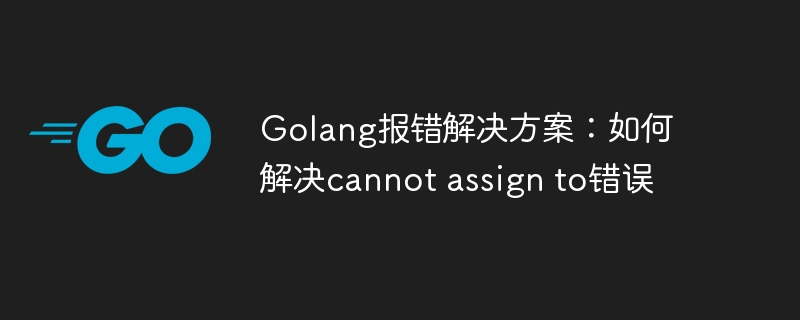Home >Backend Development >Golang >Golang error solution: How to solve the cannot assign to error
Golang error solution: How to solve the cannot assign to error
- WBOYWBOYWBOYWBOYWBOYWBOYWBOYWBOYWBOYWBOYWBOYWBOYWBOriginal
- 2023-11-25 09:38:461807browse

Golang is a very popular programming language that attracts more and more developers with its efficiency, simplicity, and ease of maintenance. However, during the development process, we will inevitably encounter some errors and exceptions. One of the common errors is the cannot assign to error. In this article we will explore the causes and how to solve the problem.
1. Reasons
In Golang, when assigning a value to a variable, the = operator is often used for assignment. However, if we use this operator in inappropriate circumstances, a cannot assign to error will occur.
Specifically, the commonly used method in Golang is to assign a value to a variable. However, in some cases, we need to obtain a pointer to a variable and then assign a value to the pointer to modify the value of the variable. And if we use this operation in inappropriate scenarios, it is easy to cause a cannot assign to error.
2. Simple example
Look at a simple example:
package main
import (
"fmt"
)
func main() {
x := 10
y := 20
fmt.Printf("原始变量值,x = %d,y = %d
", x, y)
//尝试交换变量值
x = y
y = x
fmt.Printf("交换后的变量值,x = %d,y = %d
", x, y)
}In the above code, we defined two variables x and y, and we want to exchange their values. However, after trying to use x = y and y = x, we found that the exchange was not successful and an error was reported:
# command-line-arguments ./main.go:13:3: cannot assign to x ./main.go:14:3: cannot assign to y
This is the reason for the cannot assign to error. Below we will explain how to solve this problem.
3. Solution
According to the error message that variables cannot be exchanged, we will find that variable data cannot be exchanged directly. If we want to exchange, we need to use an intermediate variable.
The following is the modified code:
package main
import (
"fmt"
)
func main() {
x := 10
y := 20
fmt.Printf("原始变量值,x = %d,y = %d
", x, y)
temp := x
x = y
y = temp
fmt.Printf("交换后的变量值,x = %d,y = %d
", x, y)
}Based on the original code, we added a temp variable. Before exchanging the values of x and y, we changed the value of the x variable Assigning a value to temp ensures that the values of x and y will not be confused, thus achieving the purpose of exchange.
In addition, if we want to operate on the pointer, we need to use the & symbol to get the address of the variable, and then operate on the pointer.
The following is a simple example:
package main
import (
"fmt"
)
func main() {
x := 10
y := &x
fmt.Println("原始变量值,x =", x)
//修改指向变量的指针的值
*y = 20
fmt.Println("改变后的变量值,x =", x)
}In this example, we define a variable x and a pointer y, which points to the memory address of x. Then, we modify the value of the pointer to the variable, and ultimately the value of the variable x.
4. Summary
The cannot assign to error is a common error in Golang development. It is mostly caused by bad habits of variable assignment or unreasonable use of pointers. In order to solve this problem, we can use intermediate variables to implement variable exchange, use pointers or address operations to operate variable values, etc.
The above is the detailed content of Golang error solution: How to solve the cannot assign to error. For more information, please follow other related articles on the PHP Chinese website!

